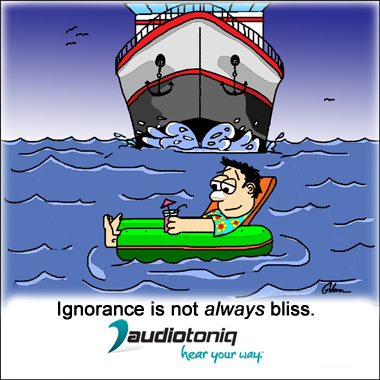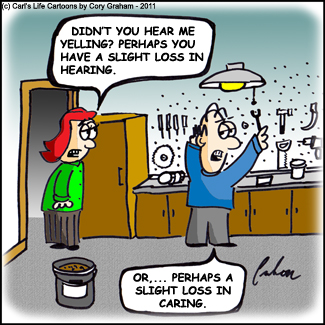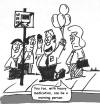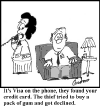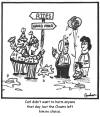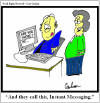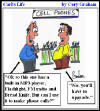|
Cartoons by Cory Graham Contact The Cartoonist Main Page | ||
|
Hearing Loss Cartoons
If you like these let me know: cory@carlslife.ca A Note on Hearing Loss: You know what hearing is, but what is hearing loss? Hearing loss, or hearing impairment, happens when there is a problem with one or more parts of the ear or ears. Someone who has hearing loss or impairment may be able to hear some sounds or nothing at all. Impairment means something is not working correctly or as well as it should. People also may use the words deaf, deafness, or hard of hearing when they're talking about hearing loss. About 3 in 1,000 babies are born with hearing impairment, making it the most common birth defect. A hearing problem can also develop later in life. To understand how and why hearing loss happens, it helps to know how the ear works. How Hearing WorksThe ear is made up of three different sections: the outer ear, the middle ear, and the inner ear. These parts work together so you can hear and process sounds. The outer ear, or pinna (the part you can see), picks up sound waves and the waves then travel through the outer ear canal. When the sound waves hit the eardrum in the middle ear, the eardrum starts to vibrate. When the eardrum vibrates, it moves three tiny bones in your ear. These bones are called the hammer (or malleus), anvil (or incus), and stirrup (or stapes). They help sound move along on its journey into the inner ear. The vibrations then travel to the cochlea, which is filled with liquid and lined with cells that have thousands of tiny hairs on their surfaces. There are two types of hair cells: the outer and inner cells. The sound vibrations make the tiny hairs move. The outer hair cells take the sound information, amplify it (make it louder), and tune it. The inner hair cells send the sound information to your hearing nerve, which then sends it to your brain, allowing you to hear.
Types of Hearing LossThere are a few different types of hearing loss: conductive, sensory, mixed (conductive and sensory combined), and neural.
What Causes Hearing Loss?Hearing loss can happen because a person was born with parts of the ear that didn't form correctly and don't work well. Other problems can happen later because of an injury or illness, including:
Lots of kids have had ear infections, which also can cause hearing loss. Permanent hearing loss is rare from an ear infection, but you need to visit the doctor if you suspect you have one.
How Does a Doctor Test for Hearing Loss?If a doctor thinks that a baby or child may have hearing loss, the doctor will recommend that the parents take him or her to an audiologist. An audiologist is someone who is specially trained to test and help with the problems related to hearing loss. A pediatric audiologist tests a child's hearing by doing different types of tests. They even have hearing tests for babies! Maybe you've had a hearing test, when you wore headphones and had to raise your left or right hand to show that you could hear in each ear. If an audiologist finds that a child has hearing loss, he or she will recommend treatment and suggest the family work with a special team. This team can help figure out the best way for the kid to learn and communicate.
How Is Hearing Loss Treated?The kind of treatment depends on the type of hearing loss, how severe it is, and the child's other needs. Common treatments include medicine, operations, hearing aids, or assistive listening devices, which emphasize voices and help kids hear better in noisy settings. With treatment, most kids will be able to hear normally again. Hearing aids are kind of like tiny amplifiers. They help someone hear sounds better and can even pick up the sounds so that what kids hear is more clear. Hearing aids deliver amplified sounds (via sound vibrations) from the eardrum and middle ear to the inner ear or cochlea. Hearing aid technology is available that can adjust the volume of sounds automatically. For some kids who are not able to hear or understand words even with the help of hearing aids, there is a device called a cochlear implant ( ko-klee-ur im-plant). This is a very tiny piece of electronic equipment that is put into the cochlea during an operation. It takes over the job of the damaged or destroyed hair cells in the cochlea by turning sounds into electrical signals that stimulate the hearing nerve directly.
|
Cartoon Topics:
Custom Search Miscellaneous: | |

